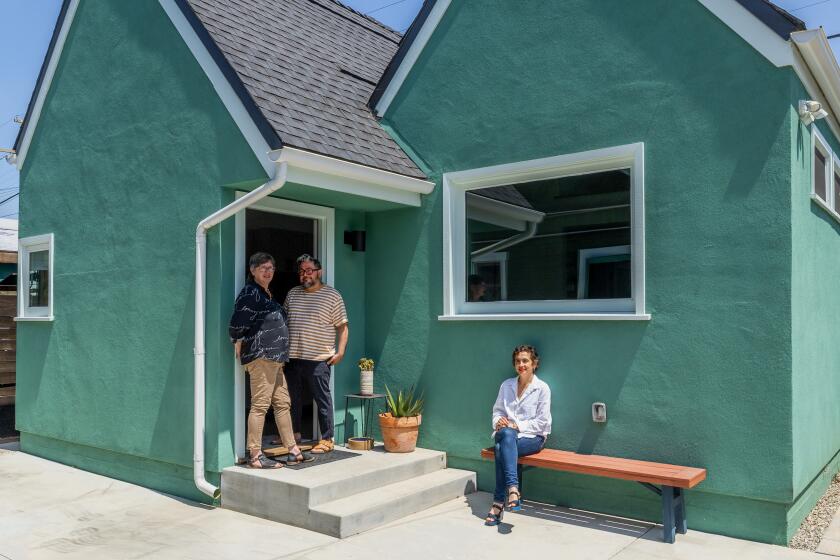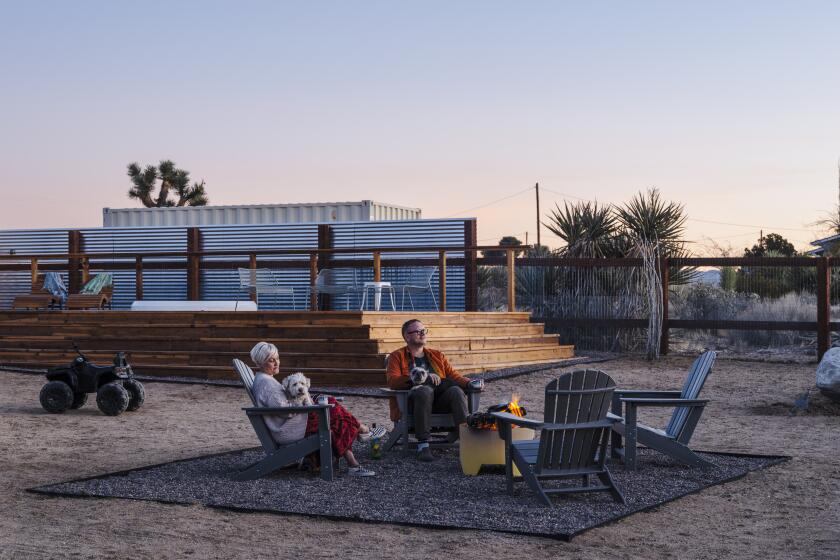COLUMN ONE : Designing Without a Blueprint : Los Angeles has fewer controls on design than most major cities. That has helped produce an unfriendly urban landscape.
For decades, architects and design experts have surveyed Los Angeles’ undistinguished landscape and asked: Why does the city look the way it does?
Why are there so many mini-malls, so many bland, boxy apartments built over gaping garages, so many featureless office buildings? When older structures in Los Angeles are demolished, why are they often replaced by lesser buildings that do not fit in with the neighborhood, buildings that often are uninspiring at best and blighted at worst?
After the first comprehensive report on the city’s planning process, some answers to these questions are emerging: Los Angeles looks the way it does, the report and design experts suggest, not only because of the avarice and shortsightedness of developers but because city government has provided little leadership or vision. City planners, the report stated, have often followed a policy of benign neglect, missing numerous opportunities to impose even minimum standards on development.
Paul Zucker, author of the highly critical management study, said Los Angeles has some of the weakest design guidelines in the country.
“Virtually every city I looked at has gone more toward an emphasis on design than Los Angeles,” said Zucker, who writes a national newsletter on planning departments. “For a city the caliber of Los Angeles I expected to see more of an urban-design function. But it simply doesn’t exist.”
The report, authorized by the city and released last summer, comes at a critical time for the Los Angeles Planning Department. City officials are searching for a new head of the department, a powerful position that could shape the look of the city into the next century.
Most planning departments in other major cities have staff members with strong architectural backgrounds. Many proposed projects must meet extensive design guidelines or pass a design review by a board of community representatives and architects. But for the vast majority of Los Angeles neighborhoods there are virtually no design guidelines of any sort, no review and few planners with any design training, planning experts say.
If a builder in Los Angeles meets the most basic zoning and building codes, “he can let her rip. . . . He just picks up the building permit and builds what he wants,” said city planner Terry Speth.
San Francisco, by contrast, has few mini-malls, has highly regarded new architecture and has kept its neighborhoods cohesive largely because of the strong design requirements in its Planning Department, Bay Area planners say.
Design is not “simply aesthetics, like what color we paint a building. . . . It has a much broader context,” Zucker said. The wrong design can reduce neighbors’ light, increase noise, eliminate views. Design can “change the scale and feel of a neighborhood, make a city more or less humane to live in.”
In cities that have strong design review guidelines--such as requiring parking behind commercial structures and apartments--residents see landscaping, innovative buildings and cafes when they walk or drive down the street. In Los Angeles, oil-stained parking lots and rows of parked cars are often the most visible images.
Some planners said the city has gone beyond merely ignoring urban design issues; it has been hostile to the process. Two of the most outspoken design advocates in the recent history of Los Angeles have been removed from their positions.
Merry Norris, who received numerous awards from architectural groups and was well respected in the design community when she headed the city’s Cultural Affairs Commission, was asked to resign in 1990 by Deputy Mayor Mark Fabiani. The commission, which has final design authority over all projects built on or over city property, long had a reputation for passivity. Norris transformed the group into an activist board that raised the standards for design.
“We ran into a lot of resistance from developers and the city,” Norris said. “The city thought we were holding up projects. The mayor’s office put a lot of pressure on us. I don’t want to say any more about it.”
Deborah Murphy, who was named urban design adviser to the mayor, also was replaced recently. Murphy, who remains a city planner, said she was told by Fabiani “that he needed to cut the budget and that urban design was not a priority for the mayor’s office.”
Los Angeles design experts say it is no coincidence that the two were replaced by less outspoken staff members.
Fabiani contends that Norris was asked to resign because she had served more than six years and “the mayor wanted to give others the chance to serve on the board.” Murphy was replaced, Fabiani said, solely for budgetary reasons--the new staff member had a lower salary.
“We’re paying more attention to the issue of design than in the past,” Fabiani said, “but budget constraints have prevented us from doing more. . . . Part of the city’s job is to make sure certain minimum standards are met. But the city also has a responsibility to ensure that it doesn’t delay the process of getting good projects approved.”
There are many ways a planning department can influence design: through review boards, through guidelines to planners, through building and zoning codes and through an activist, design-oriented planning department. Los Angeles is weak in all these areas, Murphy said.
Of the 200 planners in the department, Murphy said, she is the only architect and there are only two landscape architects. In many other cities, such as San Diego, more than 20% of the 100-member Planning Department staff has architectural backgrounds, said Mike Stepner, the San Diego city architect.
“When you have so few architects involved in the Planning Department--like Los Angeles--you encourage ugly architecture,” said Bruce Sternberg, a member of the urban design committee for the American Assn. of Architects’ Los Angeles chapter. “You get ordinances that just deal with technical issues . . . and the architectural features of projects are ignored.”
Many Los Angeles residents complain about the increasing number of apartment buildings that architects call “dingbats”--stripped-down, three-story stucco boxes set over parking spaces or garages. In many cities, unlike Los Angeles, design guidelines written into the building codes have eliminated these apartments and other kinds of schlocky architecture.
“In San Diego, you can’t build these stucco box apartments any longer,” Stepner said. “We have an ordinance that requires more architectural features, more setbacks, more of a relationship to the neighborhood, more landscaping, less obtrusive parking. By including design requirements in the ordinances it makes it clear to builders right from the beginning what our standards are.”
To eliminate mini-malls, San Francisco and other cities have simply required that parking for commercial buildings be in the rear. Los Angeles has instituted some minimal controls on mini-mall construction, such as better landscaping and parking controls. But many planners say it is too little, too late. The economic slowdown has done more to control mini-malls, they say, than local legislation.
Many cities have extensive design guidelines to help planners review projects. The San Francisco Planning Department has 42 pages of design guidelines for all residential development. But in Los Angeles, planners approve some subdivisions without even seeing drawings of the buildings, Murphy said.
“All we’ll see sometimes is the map that only shows the lot lines--we won’t even see the drawings for buildings or how they’re placed,” she said. “It could be the most horrible thing in the world and it won’t be reviewed.”
Other cities that have such limited design guidelines have design review boards that scrutinize building plans throughout the city. But Los Angeles has active design review boards for only four neighborhoods, and they examine only a small fraction of the city’s building plans. Last year, the four boards reviewed plans for only 11 new projects.
“A lot of small cities review many more buildings than Los Angeles,” said architect William Christopher, a member of the city Board of Zoning Appeals. “In fact, most cities now impose minimum common standards for design, but L.A. is well behind the curve on that.”
While Los Angeles often has been ridiculed for its sprawl and tract homes, the city has some new structures recognized nationally for their design, and many notable architects live here. Frank O. Gehry, who is based in Santa Monica, has designed a number of highly regarded buildings and won the competition for the planned Disney Concert Hall at the Music Center. The First Interstate World Center, designed by I.M. Pei’s office, and the California Gas Tower, designed by Richard Keating, also have been lauded for their design.
But many other new structures are “hotdog or show-off architecture,” said Barton Meyers, a UCLA architecture professor. These buildings, individually, are impressive but “might not fit into a neighborhood . . . so the overall look of the city is not particularly good here.”
Surrounding these standout pieces of architecture are an increasing number of “throwaway buildings” that developers erect to make a quick buck--buildings that probably will be demolished in 30 years, Meyers said. Because there are few controls on this type of construction in Los Angeles, the city is gradually growing uglier, he said.
“Cabdrivers tell me: ‘You should have seen some of these neighborhoods 20, 30 years ago. . . . They were beautiful,” said Meyers, who heads an architecture firm in Hollywood noted for design. “When cabdrivers point out the deteriorating state of architecture, you know the city is in trouble.”
Design is just one of many problem areas for the Planning Department, according to last summer’s report by Zucker. It is a highly politicized department, the audit declared, influenced by public officials who often are pressured by powerful developers or affluent homeowner groups. The report concluded that “planning in Los Angeles is at a crisis level. . . . The city needs to overcome more than a decade of inadequate attention to planning issues.”
People who move to Los Angeles from other cities often ask: “Why do they tear down the beautiful old buildings, and why do they replace them with such ugly new ones?”
The answer to both questions, Meyers said, is the same. Los Angeles has a laissez-faire tradition, an “anything goes” attitude when it comes to development.
“For too long the attitude in the city was to do what was most convenient for development interests,” said Councilman Michael Woo, who has a degree in urban planning. “And the development interests have wanted as little regulation as possible. So urban design issues were ignored.”
The Planning Department proposed setting up an urban design unit a few years ago, but it never funded the unit or hired the staff. Now, with the budget problems in city government, the proposal “probably will be dropped because of fiscal problems,” said Franklin Eberhard, chief deputy director of the Planning Department.
Zucker and a number of local planners say much is needed to turn the department around.
The Zucker audit recommended that the department follow through on the proposed design unit. But, the report concluded, “despite the department’s policy statement regarding increased focus on urban design, the department’s programs in that regard are not moving forward.”
The department also should create clear guidelines for the city’s design review boards, Zucker said, and include more design professionals.
For design to be an important part of the planning process, planners say, the new department chief must be willing to hire personnel, institute strong guidelines and make urban design a high priority within the department. But it will be difficult to implement such sweeping changes immediately because of the city’s severe budget problems.
The issue has been neglected in the past partly because some city officials have dismissed design issues as elitist--a trivial concern for the wealthy that raises the price of housing for the poor. But Harvey Molotch, in an article for “Architecture California,” wrote that design requirements do not create higher rents and can substantially benefit the poor.
“The wealthy live in cities that are like country clubs and have elected officials who are extremely responsive to homeowner needs,” said Molotch, a sociology professor at UC Santa Barbara. “The poor don’t live like this. Without design review they get the worst projects--straight-on boxes with little light that are not only ugly, but they are unsafe . . . a major concern in low-income neighborhoods.”
The lack of controls, Christopher said, also can result in a sea of mediocrity--like much of the downtown skyline. A number of recent downtown projects are exceptions largely because a few developers, such as Maguire Thomas Partners, have a commitment to design, Christopher said.
“Other cities have design divisions, architecture departments, the whole thing. . . . Los Angeles has vacancies (in leadership),” said Christopher, a former city planning commissioner. “And that’s one of the reasons the city looks the way it does.”
L.A.’s Architectural Lemons? A group that includes the local chapters of the American Planning Assn. and the American Institute of Architects awarded Oranges and Lemons for the best and worst architecture of the last decade in Los Angeles. The following are some of the Lemons: The Gene Autry Western Heritage Museum 4700 Western Heritage Way The Beverly Center Beverly and La Cienega Boulevards World Trade Center 333 S. Flower St. Valley State Bank 3575 Cahuenga Blvd. West Barrington Plaza Wilshire Boulevard and Barrington Avenue UCLA Medical Complex Le Conte Avenue between Hilgard Avenue and Westwood Boulevard
The Downtown Breakfast Club has given Roses and Lemons for the best and worst of downtown Los Angeles architecture during the past decade. The following are some of the Lemons: Bullock’s Headquarters Building 800 S. Hope St. Jewelry Mart 607 S. Hill St. The base of the Bonaventure Hotel 404 S. Hope St. Guardian Bank Building 800 S. Figueroa St. The Los Angeles Mall In the Civic Center Central Police Station 251 East 6th St. Beaudry Center I and II Beaudry Avenue and 3rd Street
More to Read
Sign up for Essential California
The most important California stories and recommendations in your inbox every morning.
You may occasionally receive promotional content from the Los Angeles Times.






